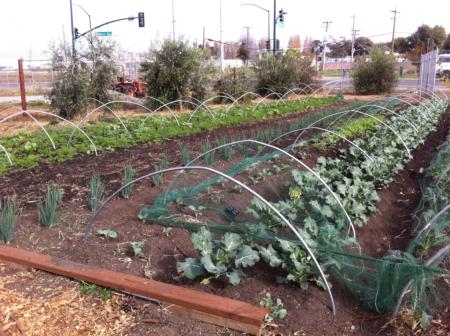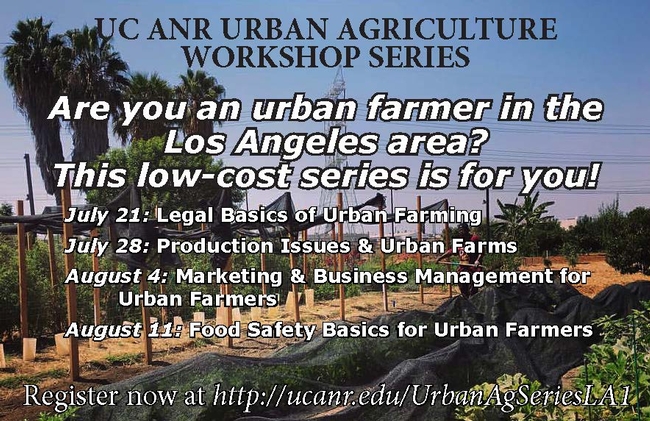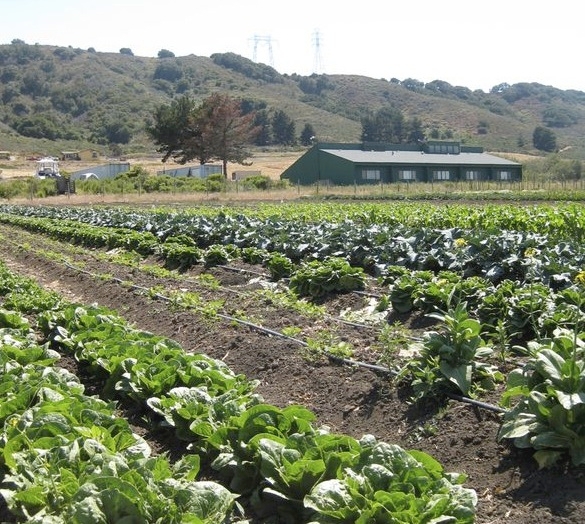Posts Tagged: food system
UC ANR hosts workshops for California's urban farmers

Building on the needs assessment, a team of UC ANR researchers created a resource website for California urban farmers. This year, team members and local partners are conducting a series of trainings for urban farmers around the state, designed to help city growers build their knowledge in key areas. The series just wrapped up in the Bay Area, and will roll out in Los Angeles starting on July 21. The Los Angeles series dates and topics are:
- July 21. Legal Basics of Urban Farming. Are you an urban farmer navigating the rules and regulations related to growing and selling food? A school or non-profit organization involved in farming? This workshop will help position you for success.
- July 28. Production Issues and Urban Farms. Are you an urban farmer learning the ins and outs of growing and harvesting crops? This workshop is designed to guide urban farmers through common production challenges related to soil, water use, and pest management.
- August 4. Marketing and Business Management for Urban Farmers. From business planning to labor laws, learn the basics to help you succeed.
- August 11. Food Safety Basics for Urban Farmers. Learn how to ensure a safe harvest, from the field to the fork.
Local partners are key to planning and hosting these events, including the Los Angeles Food Policy Council, the Collaborative for Urban Agroecology Los Angeles, Cal Poly Pomona College of Agriculture, Community Services Unlimited, GrowGood, the Growing Experience, and others.
The series will also be held in Sacramento and San Diego in early 2018. For updates and announcements, follow UC ANR's Urban Agriculture blog, Facebook, and Twitter. And be sure to bookmark our UC Urban Agriculture website which offers resources on production, policies, and more.

Urban Ag Workshop Series-SoCal 5-23-17A (3)
San Luis Obispo County local food roots are strong, can support growth

A new report assessing San Luis Obispo County's food system links the vitality of the county's agriculture with the health of its residents and its food businesses.
Conducted by the UC Sustainable Agriculture Research and Education Program (UC SAREP) and Central Coast Grown (CCG), the San Luis Obispo County Food System Assessment examines the relationships between agriculture, regional environmental quality, human health and local livelihoods.
“We found that the county food system in San Luis Obispo is thriving with increased agricultural sales and school districts beginning to participate in garden-based education,” says Jenna Smith, executive director of Central Coast Grown. “But there are many opportunities for improvement. With excitement building around local food and improved nutrition, it's vital for a county to see an honest accounting of where it stands in those arenas.”
In 2007, farmers in San Luis Obispo County sold agricultural products valued at $4.3 million directly to consumers, an increase from previous years. The report suggests that continued promotion of local and direct marketing of food can assist all producers, including new farmers, in entering the marketplace and bolstering the local food system overall.
Those markets will be especially important as the number of farmers in the county grows. In 2007, there were 850 more agricultural producers than 10 years prior. But the majority of farms in 2007 reported gross sales of under $250,000 per year, with nearly half of all farms in the county reporting less than $5,000 in annual sales.
“Unfortunately, we have little information available to define who these small-scale farmers are, what they are growing, how they impact local employment, and how they might interact with the local food system,” said Mary Bianchi, director of UC Cooperative Extension in San Luis Obispo County, who advised on the report. “We need a better understanding of what these farmers produce, and how they can better participate in the local food economy.”

In a parallel survey conducted by Central Coast Grown, they asked farmers and restaurant owners about the challenges to selling and buying locally.
“Our survey reinforced the findings of the SLO Food System Assessment,” says CCG director Smith. “Both farmers and restaurant owners reported a need and value for localized distribution channels.”
The report also addresses access to healthy food as a component of the county's food system. Participation in food assistance programs like CalFresh and food distributed by food banks in San Luis Obispo County have both increased over the last decade, though overall food insecurity in the county has improved marginally.
While increases in food distribution may mean those outlets are accessing more people, it also means more people are in need of the assistance.
Beyond continued support from government food programs, the report recommends ways that increasing food access for the public and improving markets for local producers can reinforce one another. Food-focused community development strategies such as mobile markets, community farms, and farm-to-school bring agriculture into neighborhoods and schools and help close the gap between producers and consumers.

San Luis Obispo County also faces water quality and water quantity challenges that are echoed throughout the state. Nitrate contamination from both urban and agricultural sources affects local lakes, rivers and streams. Groundwater and coastal stream resources both present significant challenges for agriculture and rural communities dependent on them for drinking water.
“Accounting for those concerns within the context of the entire food system may bring a broader scope to the discussion along with the potential to leverage the efforts of the many groups already working on water resources issues,” Bianchi said.
The Food System Assessment was conducted in partnership with the San Luis Obispo County Food System Coalition. Coalition meetings are held quarterly to discuss local food system issues and are open to the community. The report was funded by the California Department of Food and Agriculture which also supports Central Coast Grown's upcoming release of a Public Land Survey that identifies underutilized agriculturally viable land county-wide.
The report is available on the UC SAREP and Central Coast Grown websites.
The power of the foodshed

Some are surprised to learn that as recently as 1950, Los Angeles County was the No. 1 agricultural county in the United States, its farms producing an abundance of fruit, vegetables, eggs, milk, honey and much more. Today, Los Angeles residents tend to think of our county of 10 million residents in strictly urban terms, but the most current available statistics from the USDA Census of Agriculture (2007) showed 1,734 farms in L.A. County. Though ornamental plants are now our biggest crop, more than $31 million in vegetable crops came from Los Angeles County farms in 2011, according to the county’s most recent Crop and Livestock Report. The bulk of the vegetables we produce are root crops, which include onions, carrots and potatoes. Most commercial farming takes place in the high desert around Lancaster and Palmdale, and is seldom seen by most of the county’s population. A sprinkling of small urban farms is also cropping up around the county, as documented by UCLA urban planning students in their recent Cultivate Los Angeles study.
But the amount of food produced in Los Angeles County is just a tiny portion of what’s grown in our regional foodshed, defined as a 10-county region within a 200-mile radius of Los Angeles’ urban core. Our foodshed has some of the most productive farmland in the state, encompassing some 23,000 farms. Strawberries and lemons from Ventura County, lettuce and broccoli from Imperial, and milk and almonds from Kern are some of the highest-value farm products in California.
Yet much of what is produced is shipped to far away markets, and does not reach the plates of area residents. Lack of affordable fresh produce is a fact of life in many Los Angeles County neighborhoods, despite their proximity to agricultural bounty.
Looking at the overall foodshed helped the Council to conceptualize a key initiative, the Good Food Purchasing Program, which encourages institutions to buy from small- and medium-sized regional farms, along with meeting other purchasing goals that make healthy food accessible. The City of Los Angeles and LAUSD (Los Angeles Unified School District) were the first two entities to sign on. The impact of LAUSD’s efforts in purchasing regional food were recently profiled in a Los Angeles Times article that highlighted how new local jobs have been created thanks to LAUSD’s buying power. This is one example of how thinking about food regionally, and working collaboratively across sectors, can help create a stronger food system. As the director of LAUSD’s Food Services said, "It's fresher food from farmers we know," when regional food is on the menu. And, it’s good for the local economy, too.